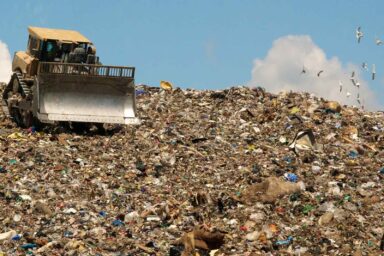Arctic Biodiversity at Risk as World Overshoots Climate Planetary Boundary
The Arctic Ocean biome is warming at twice the rate of the rest of the world. As a result, phytoplankton blooms are increasing, upsetting the system’s food chain.
This story by Gloria Dickie originally appeared in Mongabay and is republished here as part of Covering Climate Now, a global journalism collaboration strengthening coverage of the climate story.
-
- The Arctic Ocean biome is changing rapidly, warming at twice the rate of the rest of the world. In turn, multiyear sea ice is thinning and shrinking, upsetting the system’s natural equilibrium.
- Thinner sea ice has led to massive under-ice phytoplankton blooms, drawing southern species poleward; fish species from lower latitudes are moving into the peripheral seas of the Arctic Ocean, displacing and outcompeting native Arctic species.
- Predators at the top of the food chain, such as polar bears, are suffering the consequences of disappearing ice, forced onto land for longer periods of time where they cannot productively hunt.
- The Central Arctic Ocean Fisheries Agreement has been signed by 10 parties to prevent unregulated commercial fishing in the basin until the region and climate change impacts are better understood by scientists. International cooperation will be critical to protect what biodiversity remains.
Today, bowhead whales still transit the fringes of Arctic waters. Polar bears hunt blubbery ringed seals from rafts of ice. And ivory gulls ride gale force winds, plucking juvenile polar cod from the roiling sea. But for how much longer?
Despite more than a century of scientific observation, the Central Arctic Ocean remains one of the least studied bodies of water in the world. Hostile weather, multiyear sea ice, total darkness part of the year, and remoteness hinder researchers endeavoring to better understand this region, its unique biodiversity, and the dramatic shifts underway.
What we do know is this: The Arctic is changing quickly as the poles warm. Sea ice cover, which has endured for millennia, is quickly disappearing, thinning and shrinking as the biome heats up at twice the rate of the rest of the world. In the absence of ice, southern species are moving north, sometimes making refugees and relics of long-term residents.
We also know we can no longer afford for the Central Arctic Ocean to be a mystery. As the region heats up, the web of life that once tied together cold-loving species living in and near its enigmatic waters has begun to unravel, and may soon verge on collapse as the old guard fails to compete with, and gives way to, a new regime, with largely unforeseeable consequences.

All of Earth’s natural systems hang in a delicate balance. Add too much of one thing — carbon dioxide, aerosols, nitrogen, Homo sapiens — or subtract too much of another — forests, freshwater, keystone species — and suddenly biodiversity and biomes can go askew. Put more eloquently, scientists theorize that there are nine planetary boundaries beyond which limits we may not go and must abide by. If we do exceed these boundaries, our societies and species — our safe operating spaces for humanity — are in jeopardy.
So far, we’ve already surged into the danger zone for four of the nine planetary boundaries: climate change, biodiversity, land-system change, and biogeochemical flows (disruption of the nitrogen and phosphorus cycles). This is particularly bad news for Arctic Ocean biodiversity, which has felt some of the ramifications of these life-support system imbalances and shocks far sooner than anywhere else on Earth. Like dominoes falling into one another, serious changes are impacting life at the top of the world.

The Greening of the Arctic
One of the most sweeping polar biodiversity changes involves Arctic microbes: As warming sea ice cover thins, phytoplankton — free-floating microscopic marine algae — are booming.
Phytoplankton form the basis of the marine food web, and they’re dependent on sunlight to grow. In the Arctic Ocean, blooms often occur over the continental shelves after ice melts in open water when the microalgae are bathed in 24/7 sunlight in summer. Indeed, much of the biological production in the Arctic takes place in these areas due to the formation and melt of annual sea ice, which regulates the biogeochemical cycling of organic carbon and other elements in the water column.
But in 2011, scientists discovered a massive and utterly unexpected phytoplankton bloom underneath thinned Arctic sea ice in the Chukchi Sea between Alaska and Russia, one of five peripheral seas of the Arctic Ocean. Biologists had previously believed this almost impossible; sea ice and snow reflect incoming solar radiation, starving plant life of energy.
But the thinning of sea ice had allowed light to penetrate the dark waters of the Arctic Ocean, allowing phytoplankton to photosynthesize and flourish.
“Climate change has made the Arctic more productive,” says Kevin Arrigo, a biologist at Stanford University who led the study published in Science. “Because there’s so much first-year ice in the Arctic, and it’s thin and flat, light has an easier time reaching the water below.”

Arctic phytoplankton blooms now last longer. And they’re more abundant in terms of how much biomass is produced. Though scientists found evidence of such blooms occurring in the past if the conditions were exactly right, these under-ice blooms are happening more often as the “Arctic is more amenable to blooms than it used to be.”
Every Arctic species relies on energy from phytoplankton. Krill and copepods eat the plankton, which in turn are eaten by fish, which are eaten by seals, which are eaten by polar bears. “Everything starts with phytoplankton,” says Arrigo.
At first glance, the microscopic blooms would appear to be good news. More productive northern waters should help Arctic species. But that’s not strictly the case, Arrigo says. “There’s a potential dark side.” As climate change destabilizes phytoplankton at the base of the food chain, “the Arctic is becoming less like the Arctic and more like the North Pacific.”
Increasingly, southerly animals are moving in to take advantage of the new productivity.

One Fish, Two Fish, Red Fish, New Fish
Warming seas have triggered a poleward shift in fish species in the Arctic, reshuffling the food web as we know it.
The peripheral Barents Sea, north of Norway, is one of the better-studied Arctic marine regions where this species shift is occurring. When scientists surveyed 52 fish species there in a 2017 PNAS study, they found that Arctic bottom-dwelling species that feast on shellfish and invertebrates on the seafloor were gradually being replaced by incoming boreal fish species — primarily generalist species, such as cod and haddock — that eat smaller Arctic fish and outcompete native species, potentially creating an imbalance in the food system. These boreal fish have been documented moving into the North American Arctic and Eurasian Arctic.
“As the North Atlantic is warming, the cod is expanding northward,” says Maria Fossheim of the Norwegian Institute of Marine Research. “There’s now more space for it to occupy in the Barents Sea and there’s more food. In the past, subzero temperatures and sea ice stymied their Arctic advance.”
Much of this climate change-driven shift in polar fish species is occurring near the shallow continental shelf seas bordering the Central Arctic Ocean, areas traditionally neglected by the world’s large fishing fleets because commercially desirable fish had been sparse there. But inevitably, analysts say, this climate change-driven move by targeted species — including cod, haddock, and others — will lure fleets northward, putting new environmental pressures on high latitude waters.

Also, as southerly fish move in, native Arctic fish lose out. The polar cod, for example, is an ice-associated species; it feeds on zooplankton on the underside of sea ice. With less ice floating atop the ocean along with warmer temperatures, polar cod populations are expected to decline 17 percent by the end of this century.
These changes in the food chain could “alter the structure, composition and functions of future Arctic communities,” reads a recent study from researchers at Hokkaido University. By century’s end, such changes are likely to be felt in every node of the Arctic food chain, though predicting precisely what the radically altered polar marine biome will look like is impossible.
“What we’re seeing in this ecosystem is that mammals, fish, seabirds, and plankton are all moving,” says Fossheim. “The whole regime is shifting. But you can’t move everything north. At some point, some species won’t be able to live there.” Smaller fish adapted to living at 300 meters depth, for example, can’t very well move to 3,000 meter depths in the Central Arctic Basin. Soon, Fossheim says, these changes will impel biodiversity loss.

Birds of a Feather
For scientists, seabirds are the canary in the Arctic Ocean’s coal mine. “They’re very useful indicator species,” said Grant Gilchrist, a research scientist at Environment and Climate Change Canada.
Birds are long-lived; they can be marked with a band; scientists can take blood samples; and they can be tracked year to year — sometimes by satellite. All these tracking and diagnostic tools are useful in the remote Arctic environment. Birds “forage and sample in places where it’s hard for humans to sample,” Gilchrist said.
Tracking the health of seabirds and their populations, scientists can gain insights into what’s happening in the far North. Few seabirds venture far into the high Arctic; most live in high densities along the edges of the Central Arctic Ocean, around the Arctic Ocean gateways.
But the ivory gull is different. It originates in Canada, Greenland, Svalbard, and Russia, and is dependent on year-round pack ice — foraging fish and invertebrates along the productive ice edge.
However, “Their populations have been declining quite drastically,” said Kathy Kuletz, a wildlife biologist with the US Fish & Wildlife Service and a member of the Circumpolar Seabird Expert Group of the Conservation of Arctic Flora and Fauna. In the last 20 years, it’s estimated that between 80 and 90 percent of the ivory gull population has been lost. Only between 8,000 and 11,500 breeding pairs are left in the world.
In 2017, the Conservation of Arctic Flora and Fauna, the biodiversity working group of the Arctic Council, released their State of Arctic Marine Biodiversity Report. It found that some populations of seabirds in the Arctic’s lower latitudes were also declining; thick-billed murres in the Atlantic Arctic were decreasing, as were kittiwakes in the Atlantic Arctic and Davis Strait (between Greenland and Canada’s Baffin Island).
As with other species, climate change is creating winners and losers among seabirds in an altering Arctic. Though murres, ivory gulls, and kittiwakes may be struggling, planktivorous seabirds appear to be increasing in the Chukchi Sea. Conversely, little auk adults are seeing a decrease in survival rates, perhaps due to negative climate impacts on their main food source — Arctic copepods. Black guillemots in the Beaufort Sea are experiencing more breeding failures as they’ve been forced to feed their chicks lesser quality food due to a lower abundance of polar cod.

The Charismatic Megafauna
Higher up the food chain, Arctic mammals likewise face an uncertain future.
In the fall of 2021, Fisheries and Oceans Canada will begin consultations on whether to list ringed seals under the federal Species at Risk Act. These blubbery pinnipeds have historically been abundant throughout the Canadian Arctic and are considered a critical prey species for polar bears.
During the winter, when snow falls heavily on the sea ice, ringed seals dig out birth lairs in drifts above their breathing holes. This provides protection from bears. When spring comes, the ringed seals birth their pups in these lairs. But without deep snow and ice — an increasingly more common condition in a warming Arctic — ringed seals can’t protect their vulnerable young. That may be why some Inuit communities, who hunt the animals, say they’ve witnessed a decline in the seal’s numbers in recent years.
Likewise, the loss of sea ice is driving polar bears onto land where they can no longer access the seals. In a recent study, scientists examined the energy needs of polar bears forced ashore, determining that they would need to consume approximately 1.5 caribou, 37 Arctic char, 74 snow geese, 217 snow goose eggs, or 3 million crowberries to even come close to the energy provided by the blubber of a single adult ringed seal.
The polar bears have been expending far more energy searching for food now than when the sea was in its “normal” state. It’s going to be almost impossible for polar bears to adapt to life on land as the Arctic sea ice melts out.

Scientists estimate that all but a few polar bear populations will likely be gone by 2100. The animals will only likely persist in the Queen Elizabeth Islands — the northernmost part of the Canadian Arctic Archipelago — and still roam into the Central Arctic Basin past century’s end.
Narwhals, the so-called unicorns of the sea, are also struggling. Reliable breathing holes are harder to come by due to unpredictable shifts in mobile sea ice. This has led to instances of the marine mammals becoming trapped and dying under the ice.
“Anything that requires ice as a home, or a platform to hunt from, is going to start doing worse,” Arrigo said. But other transitory species, like gray whales, which feed off the productive bottom, could do really well as the Arctic becomes more productive.
“A lot of species are going to be coming in from far away,” he adds. “But that’s one of the scary things about all this. If they don’t time it correctly, and the Arctic’s productivity happens a month earlier, the migratory species coming in from the Southern Hemisphere will struggle. There’s a hard limit,” he says. In a biome as harsh as the Arctic, there’s little room for error.

So, What to Do?
In 2018, 10 parties signed an international agreement to prevent unregulated commercial fishing in the Central Arctic Ocean until scientists have a better understanding of the profound regime shifts underway. The agreement will also take into account Indigenous and local knowledge; foster scientific cooperation; and establish conservation and management measures before any fishing is permitted to occur in the vulnerable region.
Once all parties have ratified the agreement it will remain in place for 16 years, subject to automatic renewal if all parties agree. As of 2021, nine out of 10 parties have ratified the agreement, including the United States, Japan, Russia, and the European Union. Only China has yet to finalize its participation, irking some governments.
When asked by Mongabay about the delay at a policy forum in February, Gao Feng, China’s special representative for Arctic Affairs, noted that the agreement was a milestone achievement and insisted that China “has no political obstacle for the final approval. The only matter is time and our internal procedure.”
Though the climate change planetary boundary may have been crossed globally, rapid international action could curb the worst biodiversity catastrophes in the Arctic, tropics and elsewhere. And there are protection measures that can still be taken to help safeguard the world’s flora and fauna, as highlighted by the Central Arctic Ocean Fisheries Agreement.
However, such sweeping moves will take sincere cooperation between nations, a huge investment in scientific research, and rapid implementation of globally coordinated conservation efforts on a level never accomplished before. Whether this all will be accomplished in time remains to be seen. Meanwhile, the ice continues melting.
Related front page panorama photo credit: Adapted by WhoWhatWhy from Smudge 9000 / Flickr (CC BY-SA 2.0).




